Taste the brain damage! Skittles manufacturer is sued over claims that candies contain toxic dye titanium dioxide that can damage vital organs and DNA
- Mars Inc pledged to remove the toxic dye titanium dioxide from its food six years ago
- But a lawsuit filed by California woman Jenile Thames Thursday alleges that ‘elevated levels’ of the additive are still being used.
- On Thursday, a lawsuit was filed in the federal court of Oakland, California by Jenile Thames, accusing the company of using elevated levels of TiO2 food additive.
- The European Union will ban the colorful candies next month after it was deemed unsafe due to its ability to alter DNA, lawsuit claims
Skittles manufacturer Mars Inc. has been sued by a California woman who claims that a dye used in the candies is dangerous and puts people at risk of damaging their brains and DNA.
In a proposed class action filed Thursday in federal court in Oakland, California, Jenile Thames accused Mars of endangering unsuspecting Skittles eaters by using “elevated levels” of titanium dioxide, or TiO2, as a food additive.
The lawsuit highlighted how titanium dioxide will be banned in the European Union next month after a food safety regulator deemed it unsafe there due to “genotoxicity,” or its ability to alter DNA.
There are also concerns that TiO2 – used as a dye in Skittles – could damage vital organs, including the brain, if consumed in dangerous amounts.
It is generally used to give a white or cloudy background on products.
Those foods can then be repainted with the bright colors Skittles – with the tagline Taste the Rainbow – is known for.

Skittles parent company Mars Inc. has been sued in California over claims the famous candies contain a dye called titanium dioxide that can alter DNA and cause brain damage
“A reasonable consumer would expect it to be safe to buy and consume as it is marketed and sold,” the complaint said. ‘However, the products are not safe.’
The lawsuit seeks unspecified damages for fraud and violations of California consumer protection laws.
Mars did not immediately respond to requests for comment on Friday. DailyMail.com has also reached out to Thames for comment.
The McLean, Virginia-based company, which is private, had pledged in February 2016 to remove artificial dyes from its food products over the next five years.
But the Thames lawsuit alleges that this was just a ruse to keep consumers happy, and Mars Inc. keeps pumping the chemical into his candies.
She says the company should print warnings on its packaging to make consumers aware of the dangers of consuming titanium dioxide.
In October 2016, it confirmed that titanium dioxide was one of the dyes being removed, according to the nonprofit Food Safety Center, citing an email from Mars.

The case was filed in Oakland federal court on Thursday, pictured
According to the lawsuit, titanium dioxide is used in paints, adhesives, plastics and roofing materials and can cause DNA, brain and organ damage, as well as lesions in the liver and kidneys.
Thames, of San Leandro, California, said she bought Skittles from a local QuikStop in April and that she wouldn’t have done so had he known about its contents.
He said checking the label wouldn’t have helped, as the ingredients on Skittles’ bright red packaging are hard to read.
The Guardian reported that the European Food Safety Authority warned that titanium dioxide ‘can no longer be considered safe as a food additive’.
The officials added: “A critical element to coming to this conclusion is that we could not rule out concerns about genotoxicity after consumption of titanium dioxide particles.
‘After oral intake, the absorption of titanium dioxide particles is low, but they can accumulate in the body.’
